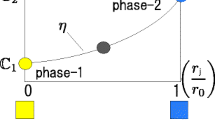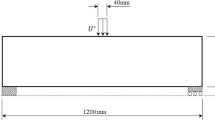Abstract
The present study proposes topology optimization of a micro-structure for composites considering the ma-cro-scopic structural response, applying a decoupling multi-scale analysis based on a homogenization approach. In this study, it is assumed that topology of macro-structure is unchanged and that topology of micro-structure is unique over the macro-structure. The stiffness of the macro-structure is maximized with a prescribed material volume of constituents under linear elastic regime. A gradient-based optimization strategy is applied and an analytical sensitivity approach based on numerical material tests is introduced. It was verified from a series of numerical examples that the proposed method has great potential for advanced material design.











Similar content being viewed by others
References
Amstutz S, Giusti SM, Novotny AA, de Souza NEA (2010) Topological derivative for multi-scale linear elasticity models applied to the synthesis of microstrucures. Int J Num Meth Eng 84:733–756
Bendsøe MP, Sigmund O (1999a) Material interpolation schemes in topology optimization. Achieve Appl Mech 69:635–654
Bendsøe MP, Sigmund O (2003) Topology optimization, theory, method and applications. Springer-Verlag, Berlin
Diaz A, Sigmund O (1995) Checkerboard patterns in layout optimization. Struct Multidisc Optim 10(1):40–45
Feyel F, Chaboche JL (2000) FE2 multiscale approach for modelling the elastoviscoplastic behaviour of long fibre SiC/Ti composite materials. Comput Methods Appl Mech Eng 183:309–330
Jog CS, Haber RB (1996) Stability of finite element models for distributed-parameter optimization and topology design. Comput Methods Appl Mech Eng 130:203–226
Kato J, Lipka A, Ramm E (2009) Multiphase material optimization for fiber reinforced composites with strain softening. Struct Multidisc Optim 39:63–81
Larsen UD, Sigmund O, Bouwstra S (1997) Design and fabrication of compliant micromechanisms and structures with negative Poisson’s ratio. J MEMS 6(2):99–106
Niu B, Yan J, Chen G (2009) Optimum structure with homogeneous optimum cellular material for maximum fundamental frequency. Struct Multidisc Optim 39(2):115–132
Patnaik SN, Guptill JD, Berke L (1995) Merits and limitations of optimality criteria method for structural optimization. Int J Num Meth Eng 38:3087–3120
Rodrigues H, Guedes JM, Bendsøe MP (2002) Hierarchical optimization of material and structure. Struct Multidisc Optim 24:1–10
Sigmund O (1994) Materials with prescribed constitutive parameters:an inverse homogenization problem. Int J Solid Struct 31(13):2313–2329
Sigmund O (2007) Morphology-based black and white filters for topology optimization. Struct Multidisc Optim 33:401–424
Sigmund O, Torquato S (1997) Design of materials with extreme thermal expansion using a three-phase topology optimization method. J Mech Phys Solids 45(6):1037–1067
Sigmund O, Pettersson J (1998) Numerical instabilities in topology optimization:a survey on procedures dealing with checkerboards, mesh-dependencies and local minima. Struct Multidisc Optim 16(1):68–75
Smit RJM, Brekelmans WAM, Meijer HEH (1998) Prediction of the mechanical behavior of nonlinear heterogeneous systems by multi-level finite element modeling. Comput Methods Appl Mech Eng 155:181–192
Su W, Liu S (2010) Size-dependent optimal microstructure design based on couple-stress theory. Struct Multidisc Optim 42(2):243–254
Terada K, Kikuchi N (2001) A class of general algorithms for multi-scale analyses of heterogeneous media. Comput Methods Appl Mech Eng 190:5427–5464
Terada K, Inugai T, Hamana Y, Miyori A, Hirayama N (2008) Parameter identification for anisotropic hyperelastic materials by numerical material testing. Trans JSCES 13(1):513–516. (in Japanese)
Terada K, Kato J, Hirayama N, Inugai N, Yamamoto K (2013) A method of two-scale analysis with micro-macro decoupling scheme: application to hyperelastic composite materials. Comput Mech. doi:10.1007/s00466-013-0872-5
Watanabe I, Terada K (2010) A method of predicting macroscopic yield strength of polycrystalline metals subjected to plastic forming by micro-macro de-coupling scheme. Int J Mech Sci 52(2):343–355
Wieckowski Z (2000) Dual finite element methods in homogenization for elastic-plastic fibrous composite material. Int J Plast 16:199–221
Zheng SF, Ding K, Denda M, Weng GJ (2000) A dual homogenization and finite-element study on the in-plane local and global behavior of a nonlinear coated fiber composite. Comput Methods Appl Mech Eng 183:141–155
Zhou M, Rozvany GIN (1991) The COC algorithm, part II : topological, geometrical and generalized shape optimization. Comp Meths Appl Mech Eng 89:309–336
Acknowledgments
This work was supported by MEXT KAKENHI Grant Numbers 23560561, 23656285. These supports are gratefully acknowledged.
Author information
Authors and Affiliations
Corresponding author
Appendix:Finite element analysis for a unit cell with external material points
Appendix:Finite element analysis for a unit cell with external material points
For preparation of the finite element analysis (FEA) for the micro-scale BVP, the spatial domain of the unit cell is discretized to generate its FE mesh. The principle of virtual work for micro-structure is formulated considering the first equation in (10) and anti-periodicity condition (8) with some mathematical rearrangement as follows:
where δ u∗ and δ ε∗ denote the virtual fluctuation displacement field and its strain field satisfying the periodic condition, respectively. The virtual work expression (33) is discretized in the finite element sense assuming the following approximation:
where N is the general shape function and B the B-operator, respectively. \(\hat {\boldsymbol {w}}^{\mathrm e}\) indicates the nodal micro-displacement vector of an element in a unit cell. Furthermore, we similarly discretize δ u∗ and δ ε∗ as \(\delta \boldsymbol {u}^{*} =\boldsymbol {N} \left ( \delta \hat {\boldsymbol {d}}^{*}{}^{\mathrm e} \right )\) and \(\delta \boldsymbol {\varepsilon }^{*} =\boldsymbol {B} \left ( \delta \hat {\boldsymbol {d}}^{*}{}^{\mathrm e} \right )\). The discretized formulation of (33) can be written by inserting these equations as follows:
As the virtual fluctuation displacement \(\delta \hat {\boldsymbol {d}}^{*}{}^{\mathrm e}\) is arbitrary, the discretized formulation of Eq. (33) is expressed by assembling Eq. (38) over the unit cell as:
where K m is the global stiffness matrix of a unit cell and \(\hat {\boldsymbol {w}}\) is the global nodal micro-displacement vector.
At this stage the boundary conditions (12) and (13) have not been included in (39) yet. In order to establish the extended micro-scale BVP aforementioned, the relative displacement q is embedded to (39) as constraints by replacing pairs of DOFs in \(\hat {\boldsymbol {w}}\). For this purpose, each external material point is also ‘discretized’ to an element with a single node which has two DOFs and no mass. Since the external material points enable us to control the components of the macro-scale stress and deformation, as explained above, the node corresponding to an external material point is referred to as a control node in this study. Thus, we obtain an extended system of FE-discretized equations involving four additional DOFs of two control nodes. In the following, we introduce some specific usages of the two control nodes to solve the extended system.
First, the macro-scale strain is assumed to be known; that is, all the components of the macro-strain E are given as data. Using (13), we obtain all the components of the nodal relative displacement vector q [k] at the two control nodes. Then, given all the components \(q_{i}^{[k]}\), we solve the extended system of FE equations with the appropriate number of ‘two-point’ constraints realized by (12).
This procedure starts from applying a transformation matrix Φ such as,
where Φ is an operator which transforms \(\hat {\boldsymbol {w}}\) to \(\tilde {\boldsymbol {w}}\) and \(\tilde {\boldsymbol {w}}\) is the nodal displacement vector in which some components are replaced by the components of q [k] . For example, concentrating only on q [1] , we impose the corresponding two points on the boundaries ∂ Y [− 1] and ∂ Y [1] whose DOFs are defined as (w a , w b ) and (w c , w d ), respectively, to be periodically constrained. Then, we can establish \(\tilde {\boldsymbol {w}}\) from \(\hat {\boldsymbol {w}}\) as shown in Fig. 3, namely
and
where N is the total number of DOFs in the unit cell without the number of DOFs of the external material points. Of course, as the above example is simply for one set of the constrained points on the ∂ Y [−1] and ∂ Y [1] , all other constrained points have to be considered in \(\tilde {\boldsymbol {w}}\) at the same time. Note that one set of q [k] (k = 1or 2) can control all constrained points staying on ∂ Y [−k] and ∂ Y [k] , see again Fig. 3.
Then, inserting (40) into (39) and pre-multiplying the operator Φ by both sides of (39) yields,
This linear equations can be condensed depending on the distribution of components of q [k] in \(\tilde {\boldsymbol {w}}\). After solving this linear equation, unknown components in \(\tilde {\boldsymbol {w}}\) are determined. The results of the FEA contain not only the micro-scale displacement \(\tilde {\boldsymbol {w}}\), strain ε and stress σ, but also the reaction force R [k] as aforementioned. This means that R [k] can be obtained by (15) since the traction force vector t [k] on ∂ Y [k] is obtained by the Cauchy law t [k] = σ e k . Therefore, the macro-stress Σ jk can be computed from (16), without performing a numerical integration on (1). Finally, as shown in (19), the macro-material stiffness \(\mathbb {C}^{\mathrm {H}}\) can be obtained by computing the macro-stress Σ jk separately three times according to the corresponding relative displacements.
Rights and permissions
About this article
Cite this article
Kato, J., Yachi, D., Terada, K. et al. Topology optimization of micro-structure for composites applying a decoupling multi-scale analysis. Struct Multidisc Optim 49, 595–608 (2014). https://doi.org/10.1007/s00158-013-0994-6
Received:
Revised:
Accepted:
Published:
Issue Date:
DOI: https://doi.org/10.1007/s00158-013-0994-6




